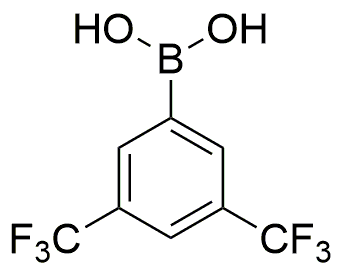3,5-Bis(trifluoromethyl)phenylboronic acid is widely utilized in research focused on:
- Drug Discovery: This compound serves as a key building block in the synthesis of various pharmaceuticals, particularly in developing new treatments for cancer and other diseases.
- Organic Electronics: It is used in the production of organic semiconductors, enhancing the performance of electronic devices such as OLEDs (Organic Light Emitting Diodes).
- Catalysis: The compound acts as a catalyst in several chemical reactions, improving efficiency and selectivity in organic synthesis, which is crucial for the chemical industry.
- Fluorinated Materials: Its unique trifluoromethyl groups contribute to the development of specialized materials with enhanced thermal and chemical stability, beneficial in coatings and polymers.
- Analytical Chemistry: This boronic acid derivative is employed in sensor technology for detecting sugars and other biomolecules, aiding in medical diagnostics and environmental monitoring.
General Information
Properties
Safety and Regulations
Applications
3,5-Bis(trifluoromethyl)phenylboronic acid is widely utilized in research focused on:
- Drug Discovery: This compound serves as a key building block in the synthesis of various pharmaceuticals, particularly in developing new treatments for cancer and other diseases.
- Organic Electronics: It is used in the production of organic semiconductors, enhancing the performance of electronic devices such as OLEDs (Organic Light Emitting Diodes).
- Catalysis: The compound acts as a catalyst in several chemical reactions, improving efficiency and selectivity in organic synthesis, which is crucial for the chemical industry.
- Fluorinated Materials: Its unique trifluoromethyl groups contribute to the development of specialized materials with enhanced thermal and chemical stability, beneficial in coatings and polymers.
- Analytical Chemistry: This boronic acid derivative is employed in sensor technology for detecting sugars and other biomolecules, aiding in medical diagnostics and environmental monitoring.
Documents
Safety Data Sheets (SDS)
The SDS provides comprehensive safety information on handling, storage, and disposal of the product.
Product Specification (PS)
The PS provides a comprehensive breakdown of the product’s properties, including chemical composition, physical state, purity, and storage requirements. It also details acceptable quality ranges and the product's intended applications.
Certificates of Analysis (COA)
Search for Certificates of Analysis (COA) by entering the products Lot Number. Lot and Batch Numbers can be found on a product’s label following the words ‘Lot’ or ‘Batch’.
*Catalog Number
*Lot Number
Certificates Of Origin (COO)
This COO confirms the country where the product was manufactured, and also details the materials and components used in it and whether it is derived from natural, synthetic, or other specific sources. This certificate may be required for customs, trade, and regulatory compliance.
*Catalog Number
*Lot Number
Safety Data Sheets (SDS)
The SDS provides comprehensive safety information on handling, storage, and disposal of the product.
DownloadProduct Specification (PS)
The PS provides a comprehensive breakdown of the product’s properties, including chemical composition, physical state, purity, and storage requirements. It also details acceptable quality ranges and the product's intended applications.
DownloadCertificates of Analysis (COA)
Search for Certificates of Analysis (COA) by entering the products Lot Number. Lot and Batch Numbers can be found on a product’s label following the words ‘Lot’ or ‘Batch’.
*Catalog Number
*Lot Number
Certificates Of Origin (COO)
This COO confirms the country where the product was manufactured, and also details the materials and components used in it and whether it is derived from natural, synthetic, or other specific sources. This certificate may be required for customs, trade, and regulatory compliance.


